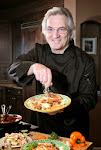I got stuck when it came to doing something different on my television program for Easter. I was exhausted from preparations for Passover -- having eight plus myself for dinner on Monday, and a business dinner on Tuesday.
Knowing full well that it's "Lamb and Ham" season, I struggled for one of my culinary "twists" and that's when I decided to do Scotch Eggs. For some reason, eggs are associated with Easter.
I remember growing up in Northeast Pennsylvania, where there was a substantial Ukranian population who brought the art of "psanki" to this country -- elaborate decoration of eggs for Easter. I also remember an elementary school teacher showing us essentially how to blow our brains out by putting a pinhole in one end of the egg and and a larger pinhole in the opposite end and then blowing out the white and the yolk so that we had a hollow vessel to paint.
When I get stuck for ideas for the TV show, I sometimes go to extremes and for some reason, the idea of doing Scotch Eggs got stuck in my head. I never made them before and I only tasted a piece of one quite a long time ago. So I researched it and it seemed simple enough.
So I had my trusty assistant Josh helping me He had worked as my sous chef at two different venues in the Missoula area and then took a break to go to Scottsdale Culinary. This kid had so much experience, he probably could have taught the teachers a thing or two. In any case, he's now working for a very high end and posh resort that closes for the winter, so he was on his annual seasonal layoff which made him available to me.
I've been hard-boiling eggs for a long time and usually get a good result. But for some reason, I had sticky shells. I did them the way I've always done them since I learned the technique in culinary school. Start the eggs in cold water. When the water boils, cover the pot and take it off the heat and after 15 minutes - not a second sooner or later -- you uncover and run cold water into the pot. The eggs are perfectly cooked and the shells should just come off when you crack them. But mine were stubborn. I wasn't sure if I had old eggs or new eggs -- they do behave differently, you know.
Josh told me to try adding a couple of tablespoons of white vinegar to the water. Since egg shells are quite porous, I guess the vinegar reacts with the membrane between the shell and the albumen, making it easier to separate. It worked.
So I had perfectly cooked and shelled hard-boiled eggs. As you'll see in the video posted with this blog, I rolled the eggs in flour because in a dredging process the object of the dredge has to have something on it that will allow the beaten egg to adhere to it so that you can coat it -- in this case with ground Italian sausage. Take about an ounce and a half -- the size of a healthy meatball and form it into a ball, then flatten it slightly in the palm of your hand. The hardboiled egg with the flour on it will then adhere to the sausage.
It's important to treat the egg with care because you want the perfectly cooked yolk to stay that way, since the Scotch Egg will eventually spend a fair amount of time in hot oil. So the sausage coating was barely an eighth of an inch thick. Then I rolled each sausage-coated egg in beaten egg and then in breadcrumbs seasoned with nutmeg, salt and pepper.
I decided to use plain -- not extra virgin -- olive oil. I heated the oil to 325, one of the lower deep frying temperatures, and placed a dredged egg on my spider and lowered it into the oil. It fried nicely and i gingerly rolled it so that the side not fully immersed in the hot oil could also take the deep fry bath.
They were a beautiful golden brown and we couldn't wait to bit into them. So we waited just a bit to let them drain on paper towels and cool down slightly.
To my surprise, I hadn't cooked them long enough because the sausage was still pretty raw. That surprised me, but then I understood the need to deep fry at the lower end of the range because in order to cook the sausage through, the breadcrumb crust really needs to go beyond golden brown -- to an almost deep brown.
The second one and those that followed were big successes. When the crew came to tape the episode and got to eat the finished product, they were a bunch of happy Easter bunnies.
Here's the video:
Wednesday, March 27, 2013
Subscribe to:
Posts (Atom)
